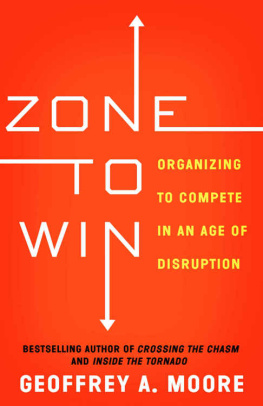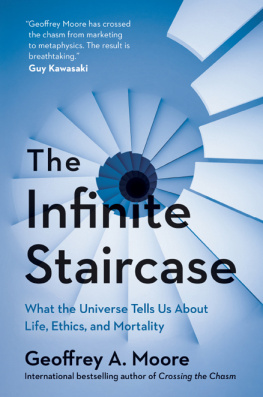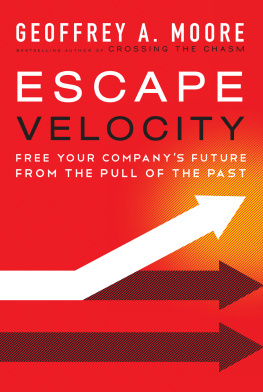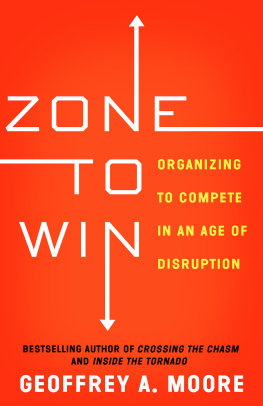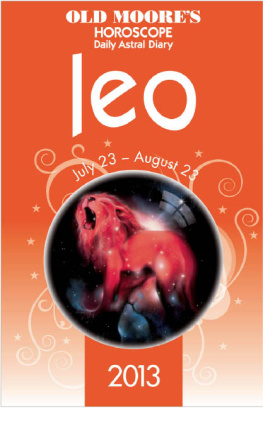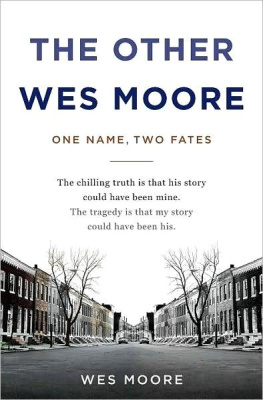Moore - Zone to Win: Organizing to Compete in an Age of Disruption
Here you can read online Moore - Zone to Win: Organizing to Compete in an Age of Disruption full text of the book (entire story) in english for free. Download pdf and epub, get meaning, cover and reviews about this ebook. year: 2015, publisher: Diversion Books, genre: Business. Description of the work, (preface) as well as reviews are available. Best literature library LitArk.com created for fans of good reading and offers a wide selection of genres:
Romance novel
Science fiction
Adventure
Detective
Science
History
Home and family
Prose
Art
Politics
Computer
Non-fiction
Religion
Business
Children
Humor
Choose a favorite category and find really read worthwhile books. Enjoy immersion in the world of imagination, feel the emotions of the characters or learn something new for yourself, make an fascinating discovery.
- Book:Zone to Win: Organizing to Compete in an Age of Disruption
- Author:
- Publisher:Diversion Books
- Genre:
- Year:2015
- Rating:5 / 5
- Favourites:Add to favourites
- Your mark:
- 100
- 1
- 2
- 3
- 4
- 5
Zone to Win: Organizing to Compete in an Age of Disruption: summary, description and annotation
We offer to read an annotation, description, summary or preface (depends on what the author of the book "Zone to Win: Organizing to Compete in an Age of Disruption" wrote himself). If you haven't found the necessary information about the book — write in the comments, we will try to find it.
Moore: author's other books
Who wrote Zone to Win: Organizing to Compete in an Age of Disruption? Find out the surname, the name of the author of the book and a list of all author's works by series.
Zone to Win: Organizing to Compete in an Age of Disruption — read online for free the complete book (whole text) full work
Below is the text of the book, divided by pages. System saving the place of the last page read, allows you to conveniently read the book "Zone to Win: Organizing to Compete in an Age of Disruption" online for free, without having to search again every time where you left off. Put a bookmark, and you can go to the page where you finished reading at any time.
Font size:
Interval:
Bookmark:
Diversion Books
A Division of Diversion Publishing Corp.
443 Park Avenue South, Suite 1008
New York, NY 10016
www.DiversionBooks.com
Copyright 2015 by Geoffrey A. Moore
All rights reserved, including the right to reproduce this book or portions thereof in any form whatsoever.
For more information, email
First Diversion Books edition November 2015
ISBN: 978-1-68230-170-8
To Noah Oak and the next generation
In 2013, Geoff was drafting the third edition of his classic book Crossing the Chasm, and he asked me about using Salesforce to illustrate some of his management principles. Many of the companies cited in the first and second editions of the book were no longer around. I was excited that Salesforce would be part of the updated book, but I also shared with Geoff that we were struggling to stay agile and focused as we grew very fast and expanded our portfolio of products. Salesforce was the leading customer relationship management platform, but internally we had developed too many conflicts and were getting pulled in too many directions. We were growing fast and innovating at a rapid pace, but we didnt have a handle on how to organize ourselves in ways that optimized for both established business units and new investment areas.
Geoff agreed to interview key managers on our teams to diagnose what was causing our dysfunction and suggest solutions. During the process, he came up with the concept of zone management. Its a deceptively simple and powerful model for resolving conflicts and accelerating business transformation.
Zone management is about dividing and conquering, establishing independent zones, each with what at Salesforce we call a V2MOMVision, Values, Methods, Obstacles, and Measures. Disruptive innovationincubating or scaling new products or business opportunitiesmust be segregated from sustaining innovationmaking improvements to existing entities. And, revenue performancefinancial commitments from the more established parts of the businessmust be separated from enabling investmentsfunding and resourcing new product and businesses opportunities. The zones act in parallel and interoperate with each other, but not in lockstep.
By looking at Salesforce through the lens of zone management, Geoff helped us improve our ability to execute in many phases of our business. Following our engagement, Geoff continued to flesh out the zone management concept, working with leaders at Microsoft to add the perspective of a forty-year-old company that was dealing with far more complexity. The end result is Zone to Win: Organizing to Compete in an Age of Disruption.
For any company, regardless of size or industry, Zone to Win is the playbook for building enterprises that reach escape velocityorienting to the future and avoiding the inertial pull of the past. Its the playbook for not just surviving but succeeding in todays disruptive, connected, fast-paced business world.
Marc Benioff, Chairman and CEO, Salesforce
August 2015
Zone to Win is the seventh, and with any luck the last, in a sequence of books about the impact of disruptive technology on business strategy and company valuations. The series began with Crossing the Chasm, first published in 1990. That book addressed the market development challenges venture-backed startups face when trying to grow beyond an early-adopter customer base and win mainstream customers. Its lessons have stood the test of time, with more than a million copies sold worldwide and a third edition with all new case examples released in 2014.
In 1995 Crossing the Chasm was followed by Inside the Tornado, which focused on the winner-take-all competitions that unfold when disruptive technologies are mature enough to displace their incumbent predecessors. It in turn was followed by The Gorilla Game, coauthored with Tom Kippola and Paul Johnson in 1998, which focused on the implications of tornado dynamics for company valuations that were at the time eye-popping, to say the least. This was the era of the dot-com bubble, or as my colleague Paul Wiefels likes to call it, the Time of the Great Happiness. It all ended in 2001.
With the bursting of the dot-com bubble, the focus of my consulting shifted to established enterprises (the ones left standing!) and how they might expect to engage with these same market dynamics. This led to a shift in perspective from that of the disruptor to that of the disruptee. It also led to a second sequence of three books, each presenting a set of frameworks to help guide management through challenging times. They included the Core/Context framework from Living on the Fault Line, the Return on Innovation framework from Dealing with Darwin, and the Hierarchy of Powers framework from Escape Velocity. All three describe strategies to better engage with disruptive innovation. What they did not do, on the other hand, was solve the problems of organization and execution.
That is the role of this book. It has been made possible through lessons learned from two consulting relationships, one with Salesforce and the other with Microsoft. Each brought me into contact with an exceptional leader and a team of executives intent not only on doing the right things but also on doing things right. Like everything in the tech sector, this too is a work in progress, but enough has been proven that it is now time to share the results.
What follows is a highly prescriptive approachindeed, a playbookfor organizing and managing established enterprises of any size in a time of category disruption. It is based on dividing up enterprise activity into four zones and managing each zone independently from the other three. In so doing it is designed to address two challenges. The first is to help management teams in established franchises manage the resource allocation challenges of onboarding a new line of business while maintaining commitments to the existing ones. This we call playing zone offense. The second is to help these same teams organize themselves to beat back a disruptive innovators attack targeting one of their mature core businesses. We call this playing zone defense. Taken together they constitute zone management, a discipline intended to let enterprises compete at full strength when it comes to engaging with the disruptive innovations that are reshaping so much of our world.
A Crisis of Prioritization
What makes modern business different? Simply put, speed plus disruption. Wave after wave of next-generation technology is continually transforming the landscape of business, both inside the tech sector, where the new offers are germinated, and everywhere else outside it, where they are largely consumed. This results in two imperatives for any established enterprise. In markets where you want to be the disruptor, where you want to play offense, you must catch the next wave. At the same time, in those markets where your current franchise is the incumbent and is itself under a disruptive attack, you have to play defense in order to prevent the next wave from catching you.
Either way, you are about to experience a crisis of prioritization, one that has stumped all but the very best of our top companies.
If you are in high tech, or for that matter in any other sector characterized by recurrent disruption, you cant sit still. You simply have to be a growth company. If your enterprise is not in a growth category, if all you are doing is optimizing your current market positions, you are a sitting duck. Operationally, that means that at any given point in time you must find a way to participate meaningfully in one or more emerging high-growth categories. You need to find a rising tide to float your boat. You need to catch the next wave to propel you forward.
Font size:
Interval:
Bookmark:
Similar books «Zone to Win: Organizing to Compete in an Age of Disruption»
Look at similar books to Zone to Win: Organizing to Compete in an Age of Disruption. We have selected literature similar in name and meaning in the hope of providing readers with more options to find new, interesting, not yet read works.
Discussion, reviews of the book Zone to Win: Organizing to Compete in an Age of Disruption and just readers' own opinions. Leave your comments, write what you think about the work, its meaning or the main characters. Specify what exactly you liked and what you didn't like, and why you think so.

